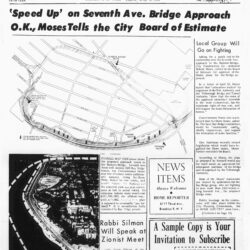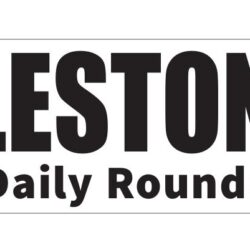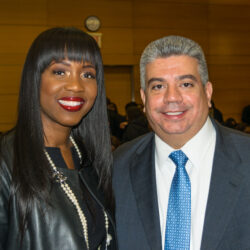
On This Day in History, April 30: Fantasy Comes to a Flushing Swamp
On April 30, 1939, the 150th anniversary of George Washington’s inauguration, President Franklin D. Roosevelt opened the 1939-40 New York World’s Fair and a crowd of half a million people jammed the fairgrounds.
Prior to June 29, 1936, there was an 1,216-acre expanse along the Flushing River in Queens that was a refuse dump used by the Brooklyn Ash Removal firm. On the June date, ground was broken to prepare the site for the fair. Mounds of refuse were leveled and water mains, sewers, and streets were installed.
New York City donated $26.7 million to the fair, the federal government $3 million, New York State $6.2 million, and foreign governments about $30 million. The fair cost $155,000,000. Admission to the fair was 75 cents for adults; 25 cents for children. Twin symbols of the fair were the Perisphere, a globe 180 feet in diameter, and the Trylon, a triangular pylon 700 feet tall, representing aspiration.
The World of Tomorrow
Emphasizing things to come, television was publicly introduced at the fair by NBC. On opening day President Roosevelt was seen arriving and delivering the opening address, thus becoming the first incumbent president to appear on television. Commercial television began the day after the fair opened — not that there was much in the way of programming, and only several thousand sets were in operation in the NYC area. More practical to the 1939 fairgoer was AT&T’s popular Demonstration Call Room, in which visitors were selected by lot to make long-distance calls to anywhere in the U.S.
The fair introduced not only television but popularized fluorescent lighting, air conditioning, nylon stockings and the Hammond Novachord, a vacuum-tube keyboard that could synthesize piano, harpsichord, trumpet, guitar and violin. And there was a fax machine that could deliver newspapers into the Living Room of Tomorrow at a rate of 18 minutes per 8 x 12-inch page.
Housewives loved “The Battle of the Centuries,” a dishwashing contest between Mrs. Drudge doing her dishes by hand and Mrs. Modern, who used a Westinghouse electric dishwasher. Especially pleasing to kids, Westinghouse also featured Elektro, the Moto-Man, a 7-foot robot that could tell jokes and count on its fingers.“Everything there is in fireworks” was presented nightly at 9:30 p.m., the climax being at 10:30, which was described as an inferno — “the nearest approach to chaos that man can contrive for purposes of sheer entertainment.”
Futurama was the shining star of the educational exhibits. General Motors offered spectators an aerial view of a typical utopion community of 1960, featuring $200 teardrop-shaped cars speeding down seven-lane superhighways. The climax was a life-size 1960 street intersection displaying 1939 GM products. Every spectator received a button to boast: “I Have Seen the Future.”
Inside the Perisphere, spectators could look down two miles from Democracity onto Utopia, a giant model of an American community of 2039. With a central work area and spread-out towns connected by landscaped highways, it was a look to a future, which certainly seemed like utopia to many fairgoers who came from crowded 1939 tenements.
The buildings and exhibits of 60 nations, based on the theme of “The World of Tomorrow,” were erected in Flushing Meadows. Most of them managed to ballyhoo political messages. On the Soviet Union’s pavilion was a plaque that announced that the “victory of socialism” was inevitable. Noticeably missing was a pavilion by Germany.
More than 57,000,000 persons attended during the two seasons of the exhibition (1939-1940), well-short of the 100 million that had been forecast. The theme of the fair was changed from “Building the World of Tomorrow” to “For Peace and Freedom.” The pavilion of the Soviet Union, featuring a statue of a worker 75-feet tall and a model of the Moscow subway, was demolished after the nonaggression pact between Stalin and Hitler and its site became the “American Common,” the scene of patriotic rallies. On July 4, 1940 a bomb exploded at the British Empire Exhibition, killing two police officers.
The highest daily attendance was 550,962 on closing day, October 26, 1940. To a Depression-weary America, jittery with war nerves, the fair was not just a collection of buildings but a dream world, a stage set on which individual and collective fantasies of a better life could be acted out, perhaps for the last time.
— V. Parker
Leave a Comment
Leave a Comment


